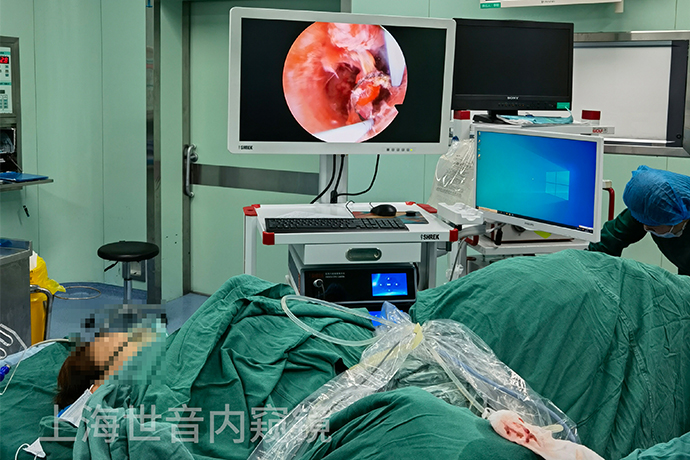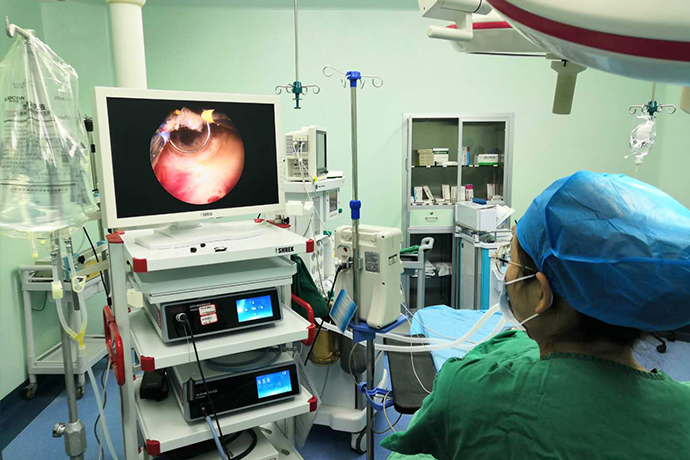【Gynecological Hysteroscopy】Endometrial Resection
Release time: 13 Sep 2022 Author:Shrek
Hysteroscopic endometrial resection is feasible for patients with functional uterine bleeding who fail conservative treatment but are unwilling to remove the uterus or cannot tolerate hysterectomy.

Indications
(1) Patients with functional uterine bleeding who are ineffective in conservative drug treatment.
(2) Those who are over 40 years old and have no childbearing requirements.
(3) Those who cannot tolerate total hysterectomy.
(4) Menorrhagia due to hematological diseases or lifelong use of anticoagulants.
(5) The size of the uterus <9 weeks of gestation, and the depth of the uterine cavity <12cm.
(6) Those with unsatisfactory results after initial endometrial resection can be operated again.
Surgical preparation
(1) Selection of operation time:
①After menstruation, the endometrium is in the early stage of hyperplasia, and the thickness of the endometrium is less than 4mm, which is the ideal time for surgery.
②For those who have undergone endometrial pretreatment, the endometrium has been thinned or atrophied, and surgery can also be performed during non-menstrual periods.
③If there is uncontrollable bleeding, emergency surgery can be performed.
(2) Anesthesia: In addition to local anesthesia, other anesthesia methods can be selected. Choose epidural anesthesia or combined spinal and epidural anesthesia.
(3) Prepare instruments and components: place the medical endoscope camera system, high-frequency electrosurgical knife, monitor, cold light source, and perfusion pump in the operating room one day before surgery to ensure good performance.
(4) Prepare basic items: package and sterilize sterile forceps, uterine expansion rods, speculum, uterine probe, uterine curette, cervical forceps, large forceps and routine dressings for gynecological perineal surgery. Prepare 1500~3 000ml of 5% glucose solution as uterine distention fluid.
Hysteroscopic endometrial resection
1. Place the negative electrode of the high-frequency electrosurgical knife in the patient's muscle plump place and fully contact the skin to prevent burns. The general choice is the buttocks.
2. Adjust the brightness of the cold light source to keep the brightness appropriate.
3. Adjust the endoscope camera system until the monitor image is clear, and wipe and disinfect the lens with 0.5% iodophor solution. First use sterile gauze dipped in iodophor solution to wipe the outer wall of the lens repeatedly for 3 minutes, and then wipe the iodophor solution with sterile dry gauze. It is confirmed by bacterial culture that the disinfection effect of this method is reliable. The iodophor solution wipe disinfection method also has the advantages of simplicity and speed.
4. dilate the cervix and put it into the speculum. The nurse arranges the dilation rods from small to large, and the donor gradually dilates the cervix until it can accommodate the outer sheath of the hysteroscope and puts it into the hysteroscope. During uterine expansion, closely observe the patient's consciousness, heart rate, blood pressure, respiration rate and blood oxygen saturation, and report any abnormalities to the anesthesiologist and the surgeon in a timely manner.
5. Hang the hanging bottle type disposable infusion set (referred to as hanging bottle) on the infusion stand, pour 500ml of 5% glucose solution as the dilatation solution, connect the input water pipe and the output water tube to ensure the smooth perfusion and discharge of the dilatation fluid. Adjust the height of the infusion stand so that the liquid level in the hanging bottle is 1m higher than the surface of the operating table. Uterine distention pressure is maintained by the liquid level difference of the distended uterine fluid. The amount of perfusion is appropriate when the surgeon can clearly see the fundus and the opening of the fallopian tubes. 5% dextrose solution is a non-ionic solution and will not shock the patient during electrocution. The dilatation of the uterus can expand the uterine cavity, and the surgical field is clear and easy to operate. The amount of fluid in the uterine cavity maintains a dynamic balance. The uterine dilatation fluid flowing out of the efferent tube can not only take away the tissue removed by electric resection, but also lower the temperature of the uterine cavity, shrink local blood vessels, and reduce bleeding. The total amount of uterine distending solution is generally 1000~3000ml.
(5) Under the monitoring of the monitor, the surgeon applies the electric cutting ring to cut the endometrium in turn.
The endometrial resection of the anterior and posterior walls is easy, but the fundal endometrium is difficult to remove, and sometimes only the endometrial tissue can be destroyed by electrocautery.
(6) After the electric resection is completed, connect the microwave therapeutic apparatus for adjuvant therapy.
Surgical Operations and Techniques
1) Dilation of the cervical canal: fully dilate the orifice of the cervical canal to 10mm, and place a hysteroscope to inspect the uterine cavity. If the endometrium is thick, the uterus can be sucked first.
2) Electric cutting method:
①Complete with a mixed current of 80~100W power, and the electric incision is deep to the superficial myometrium below the endometrium, and a rolling ball electrode can also be used to coagulate the endometrium at the bottom of the uterus.
②Using the electric resection ring clockwise or counterclockwise, starting from the fundus section, from top to bottom, sequentially remove the endometrium and superficial myometrium of the uterine wall.
③The depth of electrical resection: 2~3mm below the endometrium, this depth is enough to remove the endometrium and superficial myometrium, and it will not cut the large blood vessels and cause bleeding.
④Resection sequence: start from the posterior wall, and sequentially remove the endometrium and superficial myometrium of the lateral wall and anterior wall of the uterus. If the lower boundary terminates 1cm below the cervical os, it is a complete endometrial resection; the next term terminates 1cm above the cervical internal os, which is a partial endometrial resection.
⑤Electrode moving speed and length: The electrode moving speed should be controlled below 3cm/s, and it is advisable to have no tissue traction. The moving length of the electrosurgical ring is limited to 2.5cm. First, the upper 1/3 of the endometrium is removed, and then the middle 1/3 of the endometrium is removed. If the entire endometrium is removed, the lower 1/3 of the endometrium is removed until the cervical canal. If skilled, the cutting length can be increased by moving the resectoscope, from the fundus of the uterus to the isthmus of the uterus. The excised tissue debris can be clamped out with oval forceps to avoid obstructing the hysteroscopic view.
⑥After the resection is completed, enter the mirror again to check and remove the remaining endometrium.
⑦At the end of the operation, reduce the pressure of the uterus, observe the bleeding point, and electrocoagulate to stop the bleeding.
Precautions
1) The bottom of the palace and the corners of the two palaces are the most difficult to cut, and are prone to perforation. When cutting the endometrium of the uterine horn, it should start from 5mm away from the opening of the fallopian tube, and avoid pushing the cutting ring too deep; it can be scraped in thin layers and coagulated with a rolling ball electrode, which is safer.
2) When the dilatation pressure is insufficient, the two side walls of the uterus can be closed, the uterine horns on both sides are deep, and there is often residual endometrium.
3) If the endometrium is thick, use the rolling ball electrode to coagulate it again after the electric cut, which can improve the curative effect.
4) After resection of the endometrium and superficial myometrium, if pink or bright red endometrial tissue appears in the myometrium of the self-cut base, in the shape of a petunia, it is a adenomyosis lesion.

- Recommended news
- 【General Surgery Laparoscopy】Cholecystectomy
- Surgery Steps of Hysteroscopy for Intrauterine Adhesion
- [Gynecological Hysteroscopy] Techniques for Preventing and Treating Complications of Hysteroscopic Surgery
- [Gynecological Hysteroscopy] Hysteroscopic Adhesiolysis
- [Gynecological Hysteroscopy] IUD Removal under Hysteroscopy